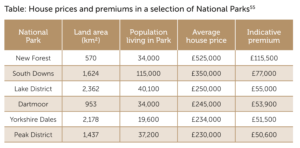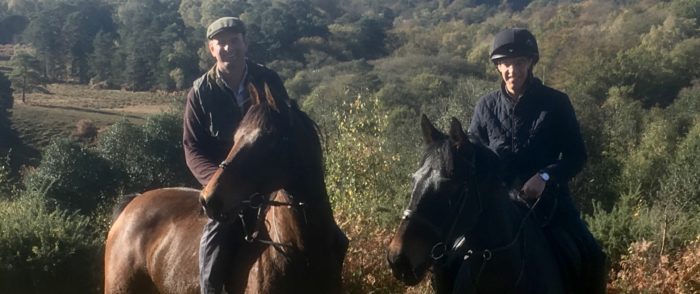Kick on! The Glover Review & The New Forest
CDA Chair, Tony Hockley, offers his personal views on the review of national landscapes
The review of Designated Landscapes led by Julian Glover faced a huge challenge: How to produce recommendations that would be appropriate across landscapes as diverse as Northumberland and the New Forest. Every designated landscape is unique and special. Thankfully, the final report is ambitious, but not prescriptive. If it is acted upon then it could create real opportunities for each landscape to do much better than today, without dictating how this is done.
There are some aspects that should have almost universal appeal. The demand for better and more secure funding for designated landscapes, and for efficient management, will be widely welcomed. Also, the demand that planning better protects these landscapes, whether in relation to development in the buffer zones around them, in upgrading the “regard” that public bodies must show these landscapes in their decisions, or in protecting and managing rights of way.
For the New Forest some things seem to leap out of the Glover Report. The demand for 1000 new rangers would be a dramatic boost. Whilst these would be unnecessary in some areas, they are desperately needed in the New Forest. Public ignorance and disinterest in its special qualities and in their fragility is diminishing it at a rapidly accelerating pace. Here the need to better connect people, particularly local people, to the landscape is urgent.
Our Heritage Lottery-funded Landscape Partnership has enabled the development of a brilliant Education Toolkit, that is now in schools, and this work could be scaled up to have a significant impact on appreciation of this incredible and rare lowland landscape. The Partnership also backs an Apprentice Ranger scheme, in which young commoners have participated, but with no career path at the end, and has backed social media and conflict resolution training for commoners. Every day the 700 New Forest commoners are engaging with the public, whilst they are out looking after their animals. But commoners have jobs too, and cannot be there as informal rangers when they are most needed. The Glover proposals could transform this situation if they are delivered. Our handful of employed rangers, and the volunteer rangers, do a fantastic job, but they are far too few in number to have much impact in such a busy landscape that is increasingly used and abused around the clock, 365 days of the year; National and local countryside laws are largely unknown and completely unenforced, with inevitable consequences. A professional group of rangers, with real recognition (as in the US) and a real career path, could make a substantial difference. It would, of course, provide a new career opportunity for commoners, that keeps some of the people who know the New Forest best within the New Forest. Alongside environmental management this provides good quality work to offset the decline in forestry employment.
Living in Landscapes
The other vital content in the report for the New Forest, relates to the economic and social pressures on the vocational commoning system upon which the landscape has always depended. Housing costs in Britain’s least affordable national park, along with few local career opportunities with decent rates of pay, and very poor public transport are driving away the young people who would continue to keep and graze livestock here if it was economically possible. For some this will be the end of a tradition stretching back generations. Whenever this happens the cultural heritage of the New  Forest suffers another loss. The proposal for a National Landscapes Affordable Housing Association could prove valuable. The report refers to the recent New Forest National Park Authority initiative to develop and rent two affordable homes at Bransgore. There are, of course, also around 65 Crown properties currently managed by Forestry England on behalf of the state. It may be more appropriate, transparent and sustainable for these to be managed by the new Housing Association focused on the local needs of the New Forest. The report also suggests that, outside of the CAP, the concept of “public money for public goods” in new Environmental Land Management Schemes (ELMS) might extend support to housing.
Forest suffers another loss. The proposal for a National Landscapes Affordable Housing Association could prove valuable. The report refers to the recent New Forest National Park Authority initiative to develop and rent two affordable homes at Bransgore. There are, of course, also around 65 Crown properties currently managed by Forestry England on behalf of the state. It may be more appropriate, transparent and sustainable for these to be managed by the new Housing Association focused on the local needs of the New Forest. The report also suggests that, outside of the CAP, the concept of “public money for public goods” in new Environmental Land Management Schemes (ELMS) might extend support to housing.
To some it may seem an esoteric point that the report suggests amending the statutory purposes of the national park authorities, but the new emphasis on “recovering” nature rather than merely “conserving” what has survived, on vibrant local communities, and on education is important. In a world of constrained public sector resources anything that is not a statutory purpose is easily neglected. The proposal for a new National Landscapes Service, effectively a regulator of our protected landscapes, could also ensure that national park authorities are directly held to account for delivering on their statutory purposes. This would be a significant improvement on the level of attention usually devoted to them by DEFRA.
Landscapes for Everyone
The report draws attention to a serious lack of connection between the population and the countryside, and the domination of white, middle-class “club”. On the one hand there is a large part of society for whom the countryside seems off-limits or has no appeal, and another for whom it is somewhere they can simply do as they please. This divide has certainly not served the New Forest well: Anyone who tries to promote appropriate behaviour has the word “park” thrown back at them, if not worse. Indeed, many of the things that people think acceptable in the New Forest would not be acceptable in a park, particularly in relation to dog control or encroachments on the common land. Glover rightly rejects that idea of introducing charging to tackle visitor pressures. Not only would this detract from the ambition to connect more people to the countryside, but would also enhance the “anything goes” entitlement mentality of those who pay to use it.
The New Forest Education Toolkit is certainly a step in the right direction, but this incredible landscape needs to be shared with far more children beyond the New Forest National Park boundary. The report proposes that every child should be entitled to an educational “night under the stars”. We could embrace this mission to connect the next generation to the countryside by repurposing the campsites on the Open Forest. These sites, located on SSSI land, are currently a real cause of concern, for the direct harm they do to the habitats and dangerous behaviour around the grazing livestock. If they are to be retained on the Open Forest, rather than moved to enclosed land, then the “Night under the Stars” initiative could well provide a route to putting them to a social purpose instead of pure income generation. An educational use could be a win-win for the New Forest and for society. Commoners could play a central role in sharing the wonder of the New Forest and the grazing animals.
Glover emphasises a need to better signify these special landscapes, particularly where multiple land managers tend to use individual and incoherent signage . “They should look and feel special” the report says. This lends weight to the new partnership project in the New Forest to make it “Special by Design”, so that the landscape becomes visually unified, whilst each land manager retains their own identity. Anyone entering the New Forest should know that they are entering somewhere very special every time they cross a cattle grid.
In conclusion, the ball is now in the Government’s court. It is unfortunate that the Secretary of State who set up the review has now moved on, and highly likely that further change is imminent. Those who care for the countryside will need to keep up the momentum.
Tony Hockley
September 2019

Members Login
 Latest Tweets
Latest Tweets
Follow us
@realnewforest 4h
Icilibus sam quas aut eriatem nume corepta auta conet officaborem quodi corepta auta conet officaborem quodi apernat ectlpa dolorpiaecus.
@realnewforest 4h
Icilibus sam quas aut eriatem nume corepta auta conet officaborem quodi corepta auta conet officaborem quodi apernat ectlpa dolorpiaecus.
@realnewforest 4h
Icilibus sam quas aut eriatem nume corepta auta conet officaborem quodi corepta auta conet officaborem quodi apernat ectlpa dolorpiaecus.
With thanks for support from




